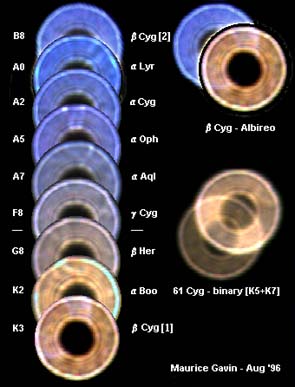
J. Brit. Astron. Assoc., 106, 5, 1996, p. 287
We are all familiar with the contrasting colours of double and other stars presented in the telescope. Renowned amateurs, like Capt W. N. Smyth (The Bedford Catalogue), made much play on them in their writings last century, and during the 1920s the Association even had a Section devoted to their study. However a better understanding of stellar temperatures made nonsense of some of these earlier descriptions.
A number of factors come into play, both instrumental and physiological, that affect our perception of star colours. The adjacent images show a dispassionate record seen by the modern electronic colour camera or CCD. The stars have been ordered to spectral class from B to K, and it is evident that stars like the Sun (G2) fall almost precisely on the neutral point (white – denoted by the horizontal bar) between the hotter blue stars and cooler yellow/orange stars.

Stars recorded pin-sharp in colour (on film or CCD) saturate the image to appear as white points and (except for some of the faintest stars) the images lack colour. This selection has been deliberately defocused so each star records as a large disk. The black spot is the central obstruction caused by the Cassegrain secondary mirror. To ensure each star was of comparable density exposures were varied from about 1s (Vega/Arcturus) to 160s (V Aql – not shown) to cover the range of stellar magnitudes. Each image was taken in a single unfiltered exposure via the Starlight Xpress colour camera. The colour is derived from the camera's inbuilt subtractive CMY filter matrix covering the pixels, and extracted semi-automatically via the Pixcolwn software. Each image received identical processing with no attempt to adjust the hue; the colour saturation (intensity) was set to the default value ×2 to make the subtle colours obvious.
Maurice Gavin
Return to Journal 1996 October contents page